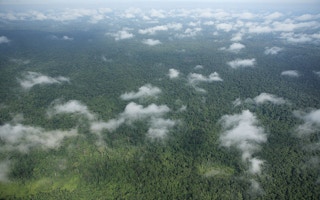Rubber plantations cover around 86,000 square kilometers (33,200 square miles) in Southeast Asia and conservationists worry they are posing an increasingly major threat to the region’s rainforests. A new study published recently in Nature Communications finds rubber profitability far exceeds carbon credit prices designed to discourage deforestation, and urges credit price hikes are needed to protect forests from industry expansion.
When it comes to forest conversion for commodity crops in Southeast Asia, palm oil is the heavy hitter, with vast plantations occupying areas where rainforest once stood. However, rubber appears to be quickly catching up, with data from the Food and Agriculture Organization of the UN indicating rubber plantations covered an area equivalent to around 67 percent of that of oil palm in 2014.
As rubber plantations expand, scientists and conservationists worry it will come at the expense of rainforests and the wildlife they contain. They say forests in Cambodia, China, Laos, Myanmar and Vietnam are particularly at risk.
“Rubber production covers a massive area – 8.6 million hectares – which equates to around two thirds of the land used for oil palm plantations,” University of East Anglia researcher Eleanor Warren-Thomas said in a statement. “It’s a big problem because these forests are irreplaceable. They are globally unique ecosystems, supporting many threatened animals, birds and plants, as well as exceptionally valuable luxury timbers such as rosewood.
Warren-Thomas said that while some of this expansion is happening through traditional methods of agroforestry in which crops are grown within a forest instead of cutting it down, the bigger share is happening through the growth of intensive monocultures fuelled by the tire industry, which requires vast tracts of cleared land.
“The consequences for biodiversity and climate change are very similar to that of oil palm,” Warren-Thomas said. “But rubber has not faced the same level of public scrutiny.”
To help alleviate this gap in scrutiny, Warren-Thomas and researchers at other universities in the UK as well as U.S.-based Wildlife Conservation Society and the Forestry Administration of Cambodia investigated how profitable rubber plantations are and if carbon credits are priced competitively enough to discourage deforestation.
“
The consequences for biodiversity and climate change (for rubber) are very similar to that of oil palm. But rubber has not faced the same level of public scrutiny.
Eleanor Warren-Thomas, researcher, University of East Anglia
The team’s results indicate that they are not. In fact, they found carbon credit prices would need to be increased six- to ten-fold to match the revenue generated by rubber plantations.
A carbon credit is a way of paying landholders to keep their forests in the ground and the carbon they contain out of the atmosphere. These credits are administered through carbon finance schemes and are important components of international commitments like the Paris Agreement that are aimed at halting climate change.
In their study, the researchers found that carbon credits are currently priced between $5 and $13 per metric ton of CO2. But in order to match the revenue generated by converting a forest to a rubber plantation, that number would need to be upped to between $30 and $51 per ton of CO2. To calculate this range they used a 10-year average price of $2,595 per ton of rubber, which is higher than current rubber prices. However, they say that even at the 2014 low of $1,644 per ton, carbon credits would need to be between $11.52 and $27.82 per CO2 ton in order to break even with rubber profits.
The researchers write that rubber prices are currently low, which may lead to a lull in rubber expansion. This, they say, could provide governments a chance to develop land use strategies that could mitigate environmental damage from agroindustry.
However, this relatively low price point has not appeared to deter industry expansion completely. For instance, Europe-based international commodity company Socfin is finishing up construction of its first rubber processing facility in the Mondulkiri province of Cambodia. In an interview with the Phnom Penh Post, Socfin General Manager Jef Boedt said he expects prices to fluctuate between $1,400 and $1,600 per ton in the coming months, but is placing a higher probability on a more upward trend.
The researchers write that as they stand now, carbon prices likely do not provide enough incentive to protect Southeast Asian forests from rubber expansion.
“Forests are less likely to be protected using carbon finance if the payments coming in are much lower than the profits the forest would generate if cut down,” Warren-Thomas said. “We show that where demand for land for rubber plantations is driving deforestation, carbon payments are unlikely to appear an attractive alternative.”
To alleviate this situation, the study recommends raising carbon prices to make them more competitive with industrial agriculture. It also urges more corporate zero-deforestation pledges as well as increased governmental regulation of plantation expansion and enforcement of forest protection.
However, Warren-Thomas expressed concern that this may not be enough.
“The threat of rubber could be reduced by the zero-deforestation pledges that have already been made by big tire companies, government regulations, or enforcement of existing forest protection laws,” she said. “But ultimately, the demand for natural rubber might only be mitigated by further development of synthetic alternatives or improvements in recycling natural rubber.”
This story was published with permission from Mongabay.com. Read the full story.










